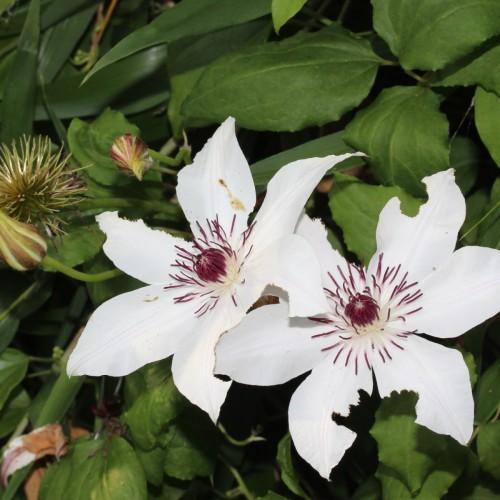
clematis
Clematis 'Snow Queen'
Cycle:
Perennial
Watering:
Average
Hardiness Zone:
4 - 8
Flowers:
Flowers
Sun:
Full sun,part shade
Leaf:
Yes
Growth Rate:
High
Maintenance:
Low
watering
Clematis ‘Snow Queen’ should be watered well during its growing season, which is in spring and summer. During this time, water deeply and regularly; this means about once a week when there is no rain and about twice a week if the weather is very hot. In late summer, reduce the amount of water but do not let the plant dry completely. During the dormant season (autumn and winter), water just enough to keep the soil barely moist.
sunlight
Clematis 'Snow Queen' is best grown in a location that receives at least 6 to 8 hours of full sun per day; however, in hot climates, it will benefit from some afternoon shade. The plant thrives in cooler temperatures and loves a sunny spot that offers it plenty of direct sunlight each day. Morning sun will help keep the foliage from becoming scorched and protect the plants from extreme heat in the afternoon. While the plant prefers to be in full sun, it can also tolerate partial shade.
pruning
Clematis 'Snow Queen' is best pruned in late winter or early spring, before new growth begins. To encourage stronger blooms and flowers, it is best to prune your Clematis 'Snow Queen' back to about 1 metre above the ground. This will help keep the plant healthy and encourage it to produce a fresh flush of blooms. Pruning should be done annually, and any dead or diseased branches should be carefully removed from the plant. Make sure to keep the pruning tools sharp to ensure a clean cut and avoid disease transmission. When pruning, be sure to keep the central stem intact as this will help promote further growth and blooms.
Season
Hardiness Map
FAQ
Can Clematis plants grow in pots?
Yes, Clematis plants can definitely be grown in pots. When planting a Clematis in a pot make sure to use a larger size pot with drainage holes and fill it with a mix of well-draining potting soil and compost. Ensure to keep the root area cool and the pot in a sunny location while providing regular water and fertilization. Check the plant almost daily to make sure it is not becoming too dry. Clematis can do well in a pot and with the right care and conditions, they will thrive.
Are Clematis plants self-pollinating?
No, clematis plants are not self-pollinating. Clematis plants need pollinators such as bees, butterflies, moths and other insects to transfer pollen from the male anthers to the female stigma of the flower in order to produce viable seed. Pollination must also occur within relatively close proximity of the same species in order to create viable hybrid plants.
Can Clematis plants be grown as a houseplant?
Yes, Clematis plants can be grown as a houseplant. It is best to grow them in a pot with full sun and a soil that is rich in organic material and retains moisture. When potting the plant, place a stake or trellis next to the pot so that the vine can climb when it begins to grow. Be sure to water your Clematis plant regularly to keep it healthy and growing. Additionally, keep an eye out for pests and treat with natural insecticides as necessary.
Could Clematis plants survive in a colder climate?
Yes, Clematis plants can survive in colder climates with proper preparation. If planted in the fall, proper mulching should be done to protect the roots from cold temperatures. If planted in the spring, they should be watered frequently to help them adjust to the cooler temperatures more quickly. If temperatures drop below -20°C ( -4°F), additional measures may need to be taken such as the application of protective wraps and thermal insulation. Additionally, plants in exposed areas should be protected from the wind to prevent excessive dehydration. With the right measures in place, Clematis plants can easily survive in colder climates.
Could Clematis plants be grown in a greenhouse?
Yes, clematis plants can be grown in a greenhouse. Due to their vine-like growth habit and tropical native origins, clematis plants thrive in the moist and warm environment of a greenhouse. Clematis are generally grown from cuttings or from dividing existing plants, and benefit from regular pruning and fertilizing. They will also enjoy the indirect light of a greenhouse and the protection from strong winds and temperatures that the humidity and contained environment provides.
